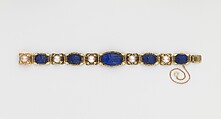Bracelet
Edward Everett Oakes American
This gold bracelet is composed of ten links: five oval links set with carved lapis scarabs alternating with five pearl-set square links. The central scarab is larger than the other four, and the back of each is carved with imitation hieroglyphics. The delicate gold mounts are fashioned as notched leaves, scrolled fiddleheads, and coronets. The clasp of the tongue is marked "OAKES" within an oak leaf surround. The scarabs and faux hieroglyphs highlight the Egyptian revival style that delighted jewelers and their patrons from the 1860s into the 1920s. Evoking exotic treasures unearthed from Egyptian royal tombs, jewelry adorned with such symbolic and talismanic motifs as scarabs ensured protection from evil and the promise of eternal life.
Jewelers of the Arts & Crafts Movement were seen as successors to the great Renaissance craftsmen, and Edward Everett Oakes was one of the premier jewelers of his era. He studied under two outstanding masters, Frank Gardner Hale and Josephine Hartwell Shaw, and he later trained his own son, Gilbert Oakes. A prominent member of the Society of Arts & Crafts, Boston, Oakes was elected a master craftsman in 1917 and was awarded a Medal of Excellence in 1923.
Due to rights restrictions, this image cannot be enlarged, viewed at full screen, or downloaded.

